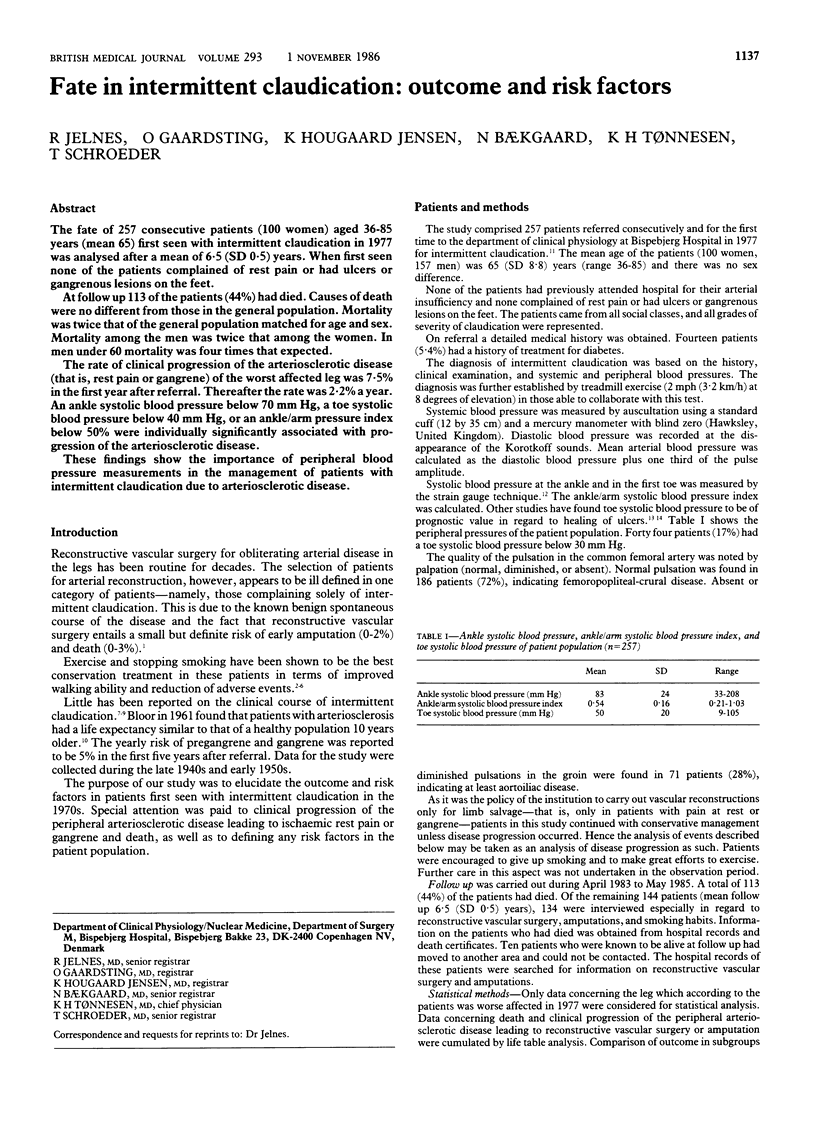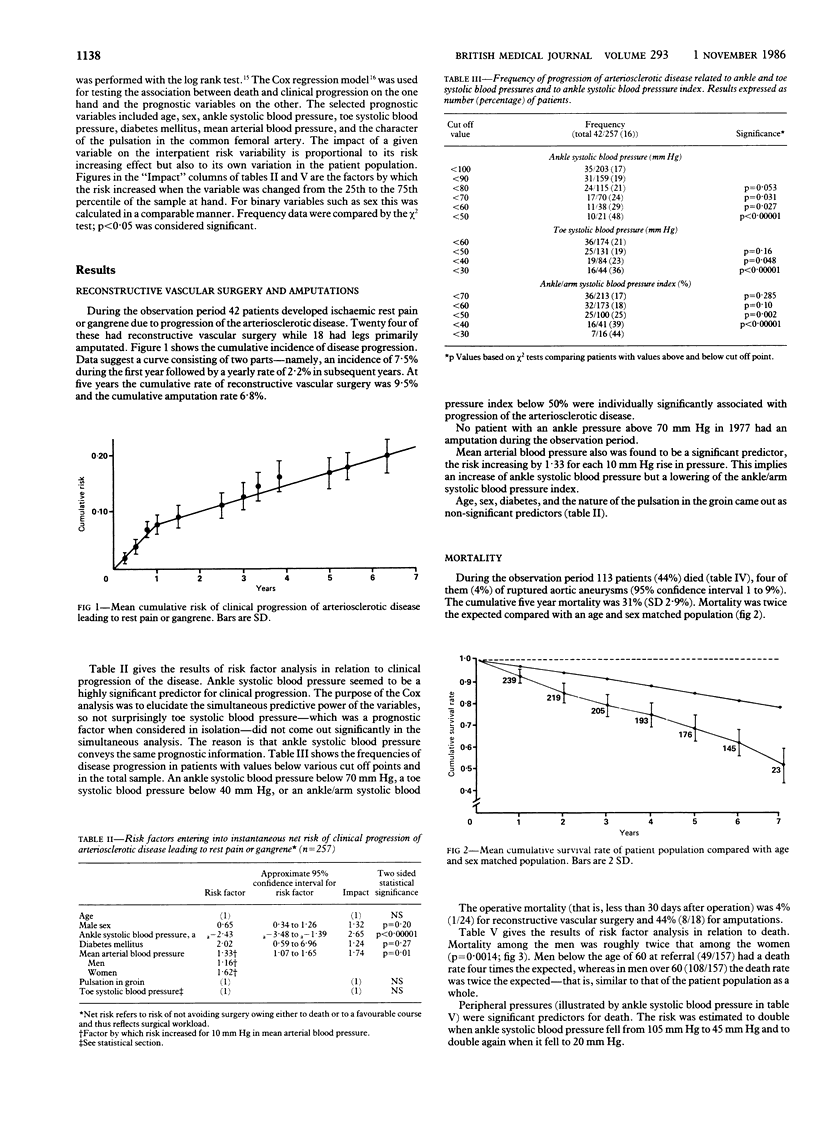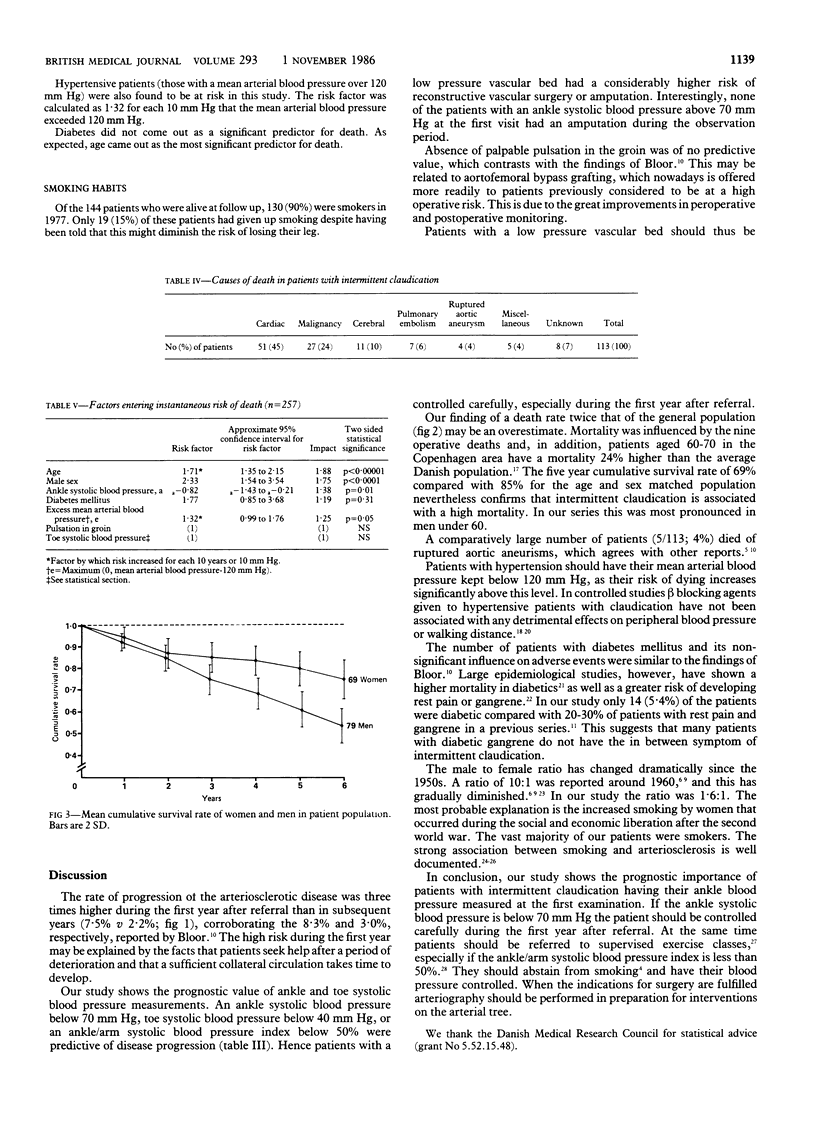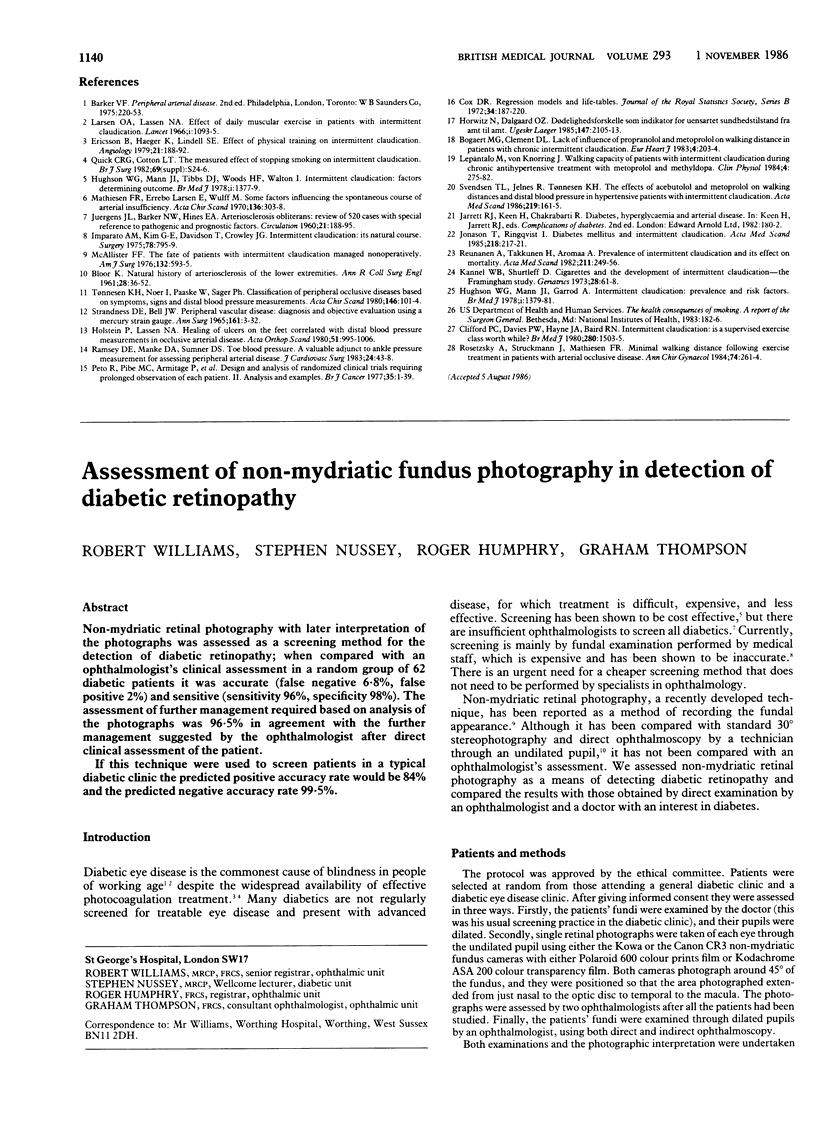Abstract
The fate of 257 consecutive patients (100 women) aged 36-85 years (mean 65) first seen with intermittent claudication in 1977 was analysed after a mean of 6.5 (SD 0.5) years. When first seen none of the patients complained of rest pain or had ulcers or gangrenous lesions on the feet. At follow up 113 of the patients (44%) had died. Causes of death were no different from those in the general population. Mortality was twice that of the general population matched for age and sex. Mortality among the men was twice that among the women. In men under 60 mortality was four times that expected. The rate of clinical progression of the arteriosclerotic disease (that is, rest pain or gangrene) of the worst affected leg was 7.5% in the first year after referral. Thereafter the rate was 2.2% a year. An ankle systolic blood pressure below 70 mm Hg, a toe systolic blood pressure below 40 mm Hg, or an ankle/arm pressure index below 50% were individually significantly associated with progression of the arteriosclerotic disease. These findings show the importance of peripheral blood pressure measurements in the management of patients with intermittent claudication due to arteriosclerotic disease.
Full text
PDF



Selected References
These references are in PubMed. This may not be the complete list of references from this article.
- Ericsson B., Haeger K., Lindell S. E. Effect of physical training of intermittent claudication. Angiology. 1970 Mar;21(3):188–192. doi: 10.1177/000331977002100306. [DOI] [PubMed] [Google Scholar]
- Holstein P., Lassen N. A. Healing of ulcers on the feet correlated with distal blood pressure measurements in occlusive arterial disease. Acta Orthop Scand. 1980 Dec;51(6):995–1006. doi: 10.3109/17453678008990906. [DOI] [PubMed] [Google Scholar]
- Horwitz N., Dalgaard O. Z. Dødelighedsforskelle som indikator for uensartet sundhedstilstand fra amt til amt. Ugeskr Laeger. 1985 Jun 24;147(26):2105–2108. [PubMed] [Google Scholar]
- Hughson W. G., Mann J. I., Garrod A. Intermittent claudication: prevalence and risk factors. Br Med J. 1978 May 27;1(6124):1379–1381. doi: 10.1136/bmj.1.6124.1379. [DOI] [PMC free article] [PubMed] [Google Scholar]
- Hughson W. G., Mann J. I., Tibbs D. J., Woods H. F., Walton I. Intermittent claudication: factors determining outcome. Br Med J. 1978 May 27;1(6124):1377–1379. doi: 10.1136/bmj.1.6124.1377. [DOI] [PMC free article] [PubMed] [Google Scholar]
- Imparato A. M., Kim G. E., Davidson T., Crowley J. G. Intermittent claudication: its natural course. Surgery. 1975 Dec;78(6):795–799. [PubMed] [Google Scholar]
- JUERGENS J. L., BARKER N. W., HINES E. A., Jr Arteriosclerosis obliterans: review of 520 cases with special reference to pathogenic and prognostic factors. Circulation. 1960 Feb;21:188–195. doi: 10.1161/01.cir.21.2.188. [DOI] [PubMed] [Google Scholar]
- Jonason T., Ringqvist I. Diabetes mellitus and intermittent claudication. Relation between peripheral vascular complications and location of the occlusive atherosclerosis in the legs. Acta Med Scand. 1985;218(2):217–221. doi: 10.1111/j.0954-6820.1985.tb08850.x. [DOI] [PubMed] [Google Scholar]
- Kannel W. B., Shurtleff D. The Framingham Study. Cigarettes and the development of intermittent claudication. Geriatrics. 1973 Feb;28(2):61–68. [PubMed] [Google Scholar]
- Larsen O. A., Lassen N. A. Effect of daily muscular exercise in patients with intermittent claudication. Lancet. 1966 Nov 19;2(7473):1093–1096. doi: 10.1016/s0140-6736(66)92191-x. [DOI] [PubMed] [Google Scholar]
- Lepäntalo M., von Knorring J. Walking capacity of patients with intermittent claudication during chronic antihypertensive treatment with metoprolol and methyldopa. Clin Physiol. 1984 Aug;4(4):275–282. doi: 10.1111/j.1475-097x.1984.tb00803.x. [DOI] [PubMed] [Google Scholar]
- Mathiesen F. R., Larsen E. E., Wulff M. Some factors influencing the spontaneous course of arterial vascular insufficiency. Acta Chir Scand. 1970;136(4):303–308. [PubMed] [Google Scholar]
- McAllister F. F. The fate of patients with intermittent claudication managed nonoperatively. Am J Surg. 1976 Nov;132(5):593–595. doi: 10.1016/0002-9610(76)90351-2. [DOI] [PubMed] [Google Scholar]
- Peto R., Pike M. C., Armitage P., Breslow N. E., Cox D. R., Howard S. V., Mantel N., McPherson K., Peto J., Smith P. G. Design and analysis of randomized clinical trials requiring prolonged observation of each patient. II. analysis and examples. Br J Cancer. 1977 Jan;35(1):1–39. doi: 10.1038/bjc.1977.1. [DOI] [PMC free article] [PubMed] [Google Scholar]
- Quick C. R., Cotton L. T. The measured effect of stopping smoking on intermittent claudication. Br J Surg. 1982 Jun;69 (Suppl):S24–S26. doi: 10.1002/bjs.1800691309. [DOI] [PubMed] [Google Scholar]
- Ramsey D. E., Manke D. A., Sumner D. S. Toe blood pressure. A valuable adjunct to ankle pressure measurement for assessing peripheral arterial disease. J Cardiovasc Surg (Torino) 1983 Jan-Feb;24(1):43–48. [PubMed] [Google Scholar]
- Reunanen A., Takkunen H., Aromaa A. Prevalence of intermittent claudication and its effect on mortality. Acta Med Scand. 1982;211(4):249–256. doi: 10.1111/j.0954-6820.1982.tb01939.x. [DOI] [PubMed] [Google Scholar]
- Svendsen T. L., Jelnes R., Tønnesen K. H. The effects of acebutolol and metoprolol on walking distances and distal blood pressure in hypertensive patients with intermittent claudication. Acta Med Scand. 1986;219(2):161–165. doi: 10.1111/j.0954-6820.1986.tb03293.x. [DOI] [PubMed] [Google Scholar]


